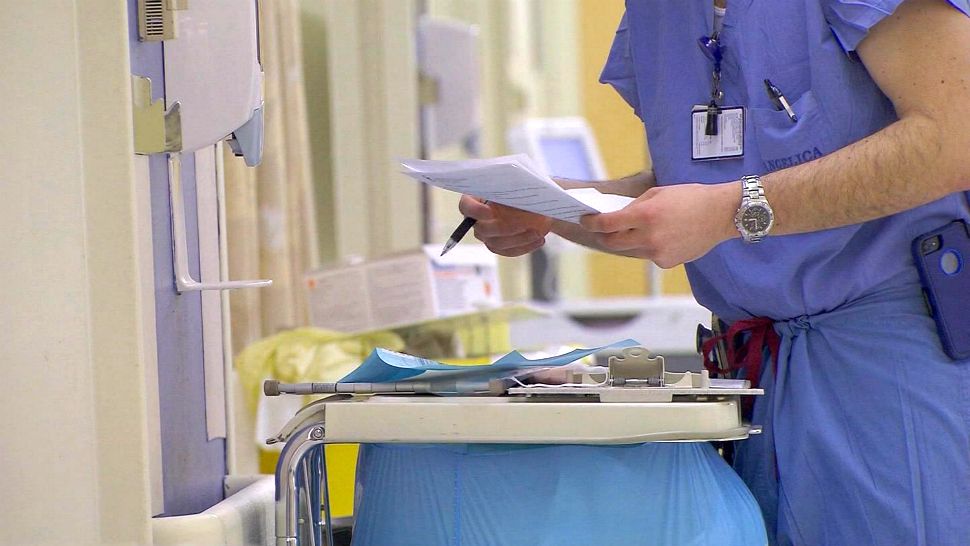LEXINGTON, Ky. — The conversation continues about whether struggling rural hospitals will close, but a new model being discussed at the federal level could save some of them.
What You Need To Know
- Study shows 40% of rural hospitals nationwide are in danger of closing
- Sixteen of Kentucky's 69 rural hospitals are "at risk"
- One rural nurse says staffing is a major concern
- A new federal model would convert existing hospitals into outpatient, emergency room-only facilities
A recent article by Kentucky Health News reported 40% of rural hospitals in the nation are in danger of closing, and 16 are in Kentucky. The article cited an analysis by the Center for Healthcare Quality and Payment Reform called “Rural Hospitals at Risk of Closing.” The report does not name the specific at-risk hospitals in Kentucky.
The report classifies 69 Kentucky hospitals as rural, and of the 16 in danger of closing, 12 have an “immediate risk” and four have a “high risk.” The report says hospitals with an immediate risk of closing have had persistent financial losses, meaning “the hospitals had a cumulative negative total margin over the most recent three-year period for which financial data were available.” They also had a low or nonexistent financial reserve, meaning the hospitals either “had total liabilities exceeding all assets other than buildings or equipment or had assets greater than liabilities, but only by enough to sustain continued losses for at most two years.”
Kristie Adkins is the operating room nurse manager at Tug Valley ARH Regional Medical Center in South Williamson, a nonprofit 163-bed facility in Pike County overlooking the Tug Fork River on the West Virginia border. She said a significant factor in many small, local hospitals closing is staffing.

“It’s been a struggle for us,” she said. “With some big hospitals paying more during the pandemic, a lot of nurses leave to make that money. If they return, it won’t be until the pandemic is no longer a concern.”
Many of the staffing agencies that work with nursing require their employees to travel a certain distance. Adkins said that many nurses in Eastern Kentucky could work in Lexington, or Huntington or Charleston, West Virginia, make more money and not be too far from their home.
“Most of the small, local hospitals close because employees leave for those better-paying jobs,” Adkins said. “A small hospital cannot replace its staff with travelers because financially it cannot pay those rates for extended periods.”
The new model being discussed at the federal level could help some of these hospitals fend off shuttering. The U.S. Congress passed a measure in 2020 to help rural hospitals, and a push urging the Biden administration to implement it is underway, according to an article in The Washington Post, which reported more than 130 rural hospitals have closed since 2010.
“Those closures have devastated local communities, resulting in long drives for emergency care, worse health outcomes for residents and job losses for the surrounding area,” according to the article. “An influx of federal aid to rural hospitals during the pandemic has not been enough to halt the trend. Last year was a record year for closures, even as rural communities relied on their hospitals more than ever for COVID-19 care and vaccination outreach.”
The new measure establishes a category called the rural emergency hospital, aimed at maintaining at least some access to care, especially in places where the hospital might otherwise close, according to the article.
“It will allow existing small rural hospitals and critical access hospitals to forgo inpatient care and convert into a new type of stand-alone emergency room and outpatient service center that can quickly transfer patients, if needed, to the closest trauma centers,” according to the article.
Many rural hospitals rely on Medicare reimbursements received by maintaining expensive inpatient beds to maintain classification as a hospital. Since locals tend to go to bigger, urban hospitals for inpatient procedures and the average rural hospital makes about 80% of its patient revenue from outpatient procedures, most rural hospitals do not need beds, according to the article.
The new model creates what is essentially a stand-alone emergency room, which Dr. Brent Wright, medical director of the T.J. Samson Medical Center in Glasgow and associate dean for Rural Health Innovation at the University of Louisville School of Medicine, said was a popular topic of discussion years ago.

“I never heard much more about its popularity,” he said. “This appears to be a resurgence of this idea with federal support, which is what it often takes to make new ideas in health care function.”
Wright said the idea makes sense in that smaller “hospitals” become more responsive to community needs that are emergent in nature. Regional facilities will likely be interested in aligning or owning these new entities to allow for a steady referral stream of inpatients.
“I also wonder about the utilization of telemedicine within these stand-alone emergency rooms to link larger centers with more resources to areas that cannot feasibly staff OB physicians, cardiothoracic surgeons or neurosurgeons,” he said. “Can telemedicine be utilized and compensated on both ends to make it financially impactful to all parties?”
The Kentucky Health News article looked at the Ephraim McDowell James G. Haggin Hospital in Harrodsburg, which lost more than $863,000 from 2017-19. William Snapp, the chief financial officer of Ephraim McDowell Health in Danville, was quoted as saying James G. Haggin was losing money. Still, since becoming part of McDowell's centralized system, along with some changes in how it operates, it now has a positive margin and is not at risk of closing.
The model highlights whether the new model would provide enough income for sustainability with regard to staffing as well, Wright said.
“Are you going to allow an advanced practice registered nurse to be the provider for the facility, or are you going to have a board-certified emergency room physician,” he said. “Care has costs and demographics will challenge communities to work within this model to find the right model or right partner to make a go of this new hospital construct.”
According to preliminary research from health care experts at the University of North Carolina, about 68 hospitals in the U.S. would likely convert to the new model. Brock Slabach, of the National Rural Health Association, told The Post it could take a while for the latest model to catch on, and that rural emergency hospitals may play a more prominent role over the long term.
“The last time Congress created a new category for rural health care, with critical access hospitals in 1997, few hospitals adopted the new designation right off the bat,” Slabach said. “Now, there are 1,300.”
Kentucky Hospital Association Director of Communications Ginger Dreyer said the model is being reviewed, but it is too soon to say which rural hospitals in Kentucky would likely make the conversion.
“I've seen a lot of models come and go, but I think what's important for rural and community hospitals is for them to have options,” Wright said. “I think that they have to have options to be sustainable. At the end of the day, these hospitals are businesses, they may be nonprofits, but they have to have the revenue to keep the doors open. As populations shift, as needs shift, as health care innovation shifts, people are going to go to bigger hospitals and get care there.”
Other hospitals with similar financial numbers to James G. Haggin’s cited in the report are the Kentucky River Medical Center in Jackson and AdventHealth Manchester. The Jackson hospital lost an average of $1.6 million annually from 2017-19, an operating margin of minus 5.2%, and the Manchester hospital, part of a nine-state chain based in Florida, showed a minus 4.1% margin in 2017-19, representing a loss of $2.4 million.
Efforts to help Kentucky’s rural hospitals have also been discussed recently in Frankfort. The General Assembly passed House Bill 387 during the 2020 session, which called for the creation of a revolving loan fund for distressed rural hospitals, but the bill was never funded. New legislation was filed and passed during this year’s session in House Bill 183, which allows Kentucky hospitals to get more money from Medicaid at an “average commercial rate” instead of the current Medicaid rate, which is often below that amount.
The bill’s primary sponsor, Rep. Brandon Reed, R-Hodgenville, told the House about a report by the KHA that shows pandemic challenges have cost Kentucky hospitals $2.6 billion in losses, many of which were already struggling financially, according to Kentucky Health News.
Five hospitals have closed in Kentucky since 2009 and four since 2014. The most recent was Our Lady of Bellefonte Hospital in Russell, which closed in April 2020, according to a report from the KHA. The report also shows rural hospitals in Kentucky employ more than 24,000 people and rely heavily on government payers, with the state having the sixth-highest percentage of hospital patients covered by Medicare or Medicaid.



